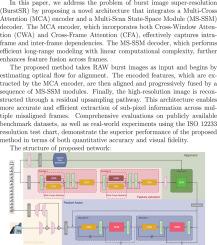Burst image super-resolution via multi-cross attention encoding and multi-scan state-space decoding
IF 4.2
3区 计算机科学
Q2 COMPUTER SCIENCE, ARTIFICIAL INTELLIGENCE
引用次数: 0
Abstract
Multi-image super-resolution (MISR) can achieve higher image quality than single-image super-resolution (SISR) by aggregating sub-pixel information from multiple spatially shifted frames. Among MISR tasks, burst super-resolution (BurstSR) has gained significant attention due to its wide range of applications. Most existing methods use fixed and narrow attention windows, limiting feature perception and hindering alignment and aggregation. To address these limitations, we propose a novel feature extractor that incorporates two newly designed attention mechanisms: overlapping cross-window attention and cross-frame attention, enabling more precise and efficient extraction of sub-pixel information across multiple frames. Furthermore, we introduce a Multi-scan State-Space Module with the cross-frame attention mechanism to enhance feature aggregation. Extensive experiments on both synthetic and real-world benchmarks demonstrate the superiority of our approach. Additional evaluations on ISO 12233 resolution test charts further confirm its enhanced super-resolution performance.

通过多交叉注意编码和多扫描状态空间解码实现突发图像超分辨率
多图像超分辨率(MISR)通过聚合多个空间移位帧的亚像素信息,可以获得比单图像超分辨率(SISR)更高的图像质量。在MISR任务中,突发超分辨率(BurstSR)由于其广泛的应用受到了广泛的关注。大多数现有的方法使用固定和狭窄的注意窗口,限制了特征感知,阻碍了对齐和聚合。为了解决这些限制,我们提出了一种新的特征提取器,该提取器结合了两种新设计的注意机制:重叠跨窗口注意和跨帧注意,从而能够更精确、更有效地提取跨多帧的亚像素信息。此外,我们还引入了一个多扫描状态空间模块,该模块具有跨帧关注机制,以增强特征聚合。在合成基准和实际基准上进行的大量实验证明了我们方法的优越性。ISO 12233分辨率测试图的附加评估进一步证实了其增强的超分辨率性能。
本文章由计算机程序翻译,如有差异,请以英文原文为准。
求助全文
约1分钟内获得全文
求助全文
来源期刊

Image and Vision Computing
工程技术-工程:电子与电气
CiteScore
8.50
自引率
8.50%
发文量
143
审稿时长
7.8 months
期刊介绍:
Image and Vision Computing has as a primary aim the provision of an effective medium of interchange for the results of high quality theoretical and applied research fundamental to all aspects of image interpretation and computer vision. The journal publishes work that proposes new image interpretation and computer vision methodology or addresses the application of such methods to real world scenes. It seeks to strengthen a deeper understanding in the discipline by encouraging the quantitative comparison and performance evaluation of the proposed methodology. The coverage includes: image interpretation, scene modelling, object recognition and tracking, shape analysis, monitoring and surveillance, active vision and robotic systems, SLAM, biologically-inspired computer vision, motion analysis, stereo vision, document image understanding, character and handwritten text recognition, face and gesture recognition, biometrics, vision-based human-computer interaction, human activity and behavior understanding, data fusion from multiple sensor inputs, image databases.
 求助内容:
求助内容: 应助结果提醒方式:
应助结果提醒方式:


